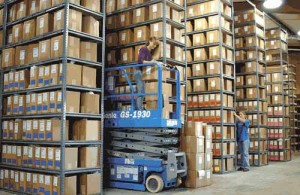Have you taken the time to define your company’s inventory carrying costs? More importantly, are you aware of how these carrying costs reduce gross profit and impact your company’s bottom line? If not, then it’s about time you identify your inventory’s biggest cost drivers. These costs don’t merely include the price paid for parts and raw materials. They also include the per-unit freight costs on incoming and outgoing shipments, the costs of inventory obsolescence, inventory damage, ruined inventory, the cost of money, warehousing costs, storage and electricity costs, as well as miscellaneous costs of lost sales & lost customers due to low inventory counts. Granted, there are a lot of items to cover. However, all of these items play a pivotal role in your company’s costs to carry inventory. As such, it’s essential your company adopts plans to reduce their impact.
Most companies are shocked to hear just how much it costs them to support their inventory. Unfortunately, most companies fail to itemize these costs. In essence, they don’t correlate these expenses back to the company’s inventory. Instead, these costs seem to be chalked up to the costs of doing business. However, once companies take the time to itemize these expenditures, they can then adopt strategies to mitigate their effects. If done properly, companies can track these costs from one quarter to the next. Afterwards, adjustments can be made and the company can effectively reduce these costs year over year. We’ll itemize and explain each of these cost drivers and provide you with some insight into how much they may be impacting your company’s bottom line.
1. Cost of freight
Tracking your company’s freight costs is an essential part of effectively reducing your carrying costs. How often does your company cover urgent shipments for being late on customer orders when inventory wasn’t available? Consequently, how often does your company rush parts in from suppliers because of inaccurate inventory counts? Many companies get hit with the proverbial “double whammy” freight bill because of low inventory levels. They lack the inventory to meet forecasted demand and are forced to rush parts into the warehouse from suppliers, before rushing those same parts out to fulfill customer orders. If they’re lucky, their suppliers’ won’t charge them expedite fees or overtime. However, the company is guaranteed to encounter high freight expenses due to a lack of available inventory and or, inaccurate inventory counts.
2. Obsolete, damaged & ruined inventory
The longer inventory is retained, the more likely it is to become obsolete, damaged or worse, ruined. When inventory becomes damaged, a number of companies are able to assess the costs of reworking that inventory. If the costs justify the time, then companies may still be able to derive a profit. However, there is little the company can do once the inventory becomes damaged beyond repair. In these cases, the company must completely scrap the inventory. A large portion of these inventory costs are driven by the inability of sales to sell slow moving inventory, inaccurate sales forecasts, poor marketing strategies, improper counting methods and a purchasing strategy that’s sometimes predicated on purchasing more in order to drive down costs. What companies fail to realize is the costs they incur to retain this inventory for extended periods. Again, the longer inventory is held, the more expensive it becomes.
3. Your company’s cost of money
What exactly is the cost of money? To answer this question, think of the company’s financing costs. Most companies use credit lines and business loans to finance their inventory. These financing vehicles have a yearly interest rate that the company must pay to borrow money. That yearly rate can be converted into a daily interest rate, and subsequently, a daily cost of money. Therefore, every day inventory is held and not sold, is yet another day the company must cover this interest rate. It’s just another reason why the longer inventory is held, the more expensive it becomes.
4. Warehousing, storage & electricity costs
There are a number of expenses relative to managing the company’s warehouse. Even for those companies that own their warehouse outright, there are still monthly costs of storage and electricity. Depending upon the product sold and market serviced, some companies must maintain a specific temperature within their warehouse in order to guard against inventory damage. In other instances, companies merely want to make sure that employees are working in a comfortable environment. However, there is yet another concern. When a company tracks the results of its sales, they often find that their fastest selling products require a larger portion of their overall warehouse space. This makes that space allocated for slower moving products extremely expensive. In fact, in some cases, companies retain that slow moving inventory and then decide to rent additional space for their higher turnover rate products. This does nothing more than increase the company’s inventory costs.
5. Lost sales & customers due to low inventory
Surprised to hear that lost sales and lost customers are a direct cost of inventory? Don’t be! Any cost that can be traced to inventory can be seen as a cost of inventory. Losing sales and customers because inventory wasn’t available makes carrying inventory more difficult. It leads to apprehension on the part of sales & procurement. The procurement department will be less inclined to follow sales forecasts, and the sales team will become less inclined to move slow moving inventory. Some of these issues pertain to inaccurate inventory counts, poor planning, long supplier lead times and yet others pertain to inaccurate sales forecasting. However, the impetus must be on bridging the gap between sales & procurement in order to make sure that the sales team has the inventory needed to capture opportunistic sales, and that procurement has the support of the sales team in selling slow moving inventory.
When looking at your company’s carrying costs, be sure to account for these aforementioned items. The only way to ascertain their impact is to track them over a given quarter and year. The best and brightest companies track these costs and are proactive in reducing their effects. After completing this exercise, a number of companies begin to see their inventory as a profit center. After all, there are two ways to increase a company’s gross profit. One is through sales and the other is through lowering costs. It’s the main reason why a number of companies set profit objectives for their procurement department. Take the time to itemize these costs. Reducing them is akin to growing your company’s sales.

